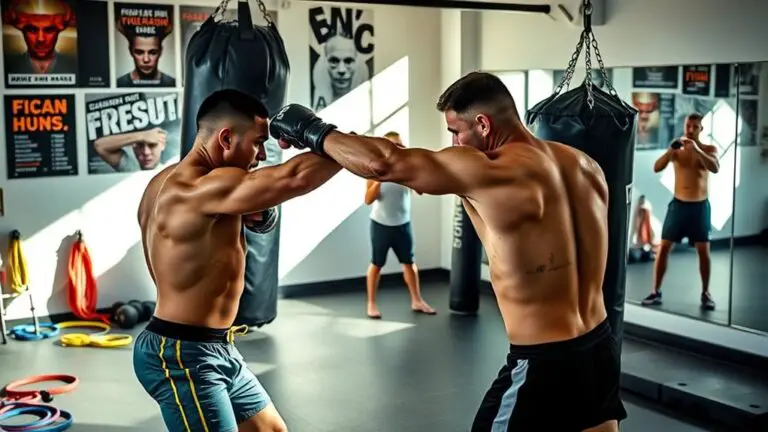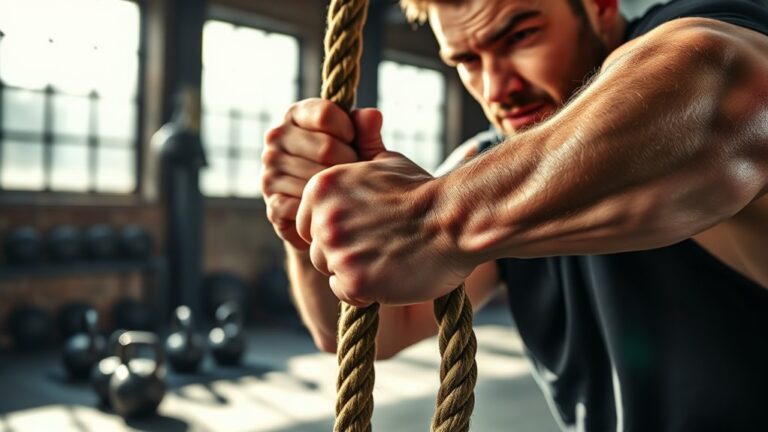The Best Gym Workouts for Rock Climbers
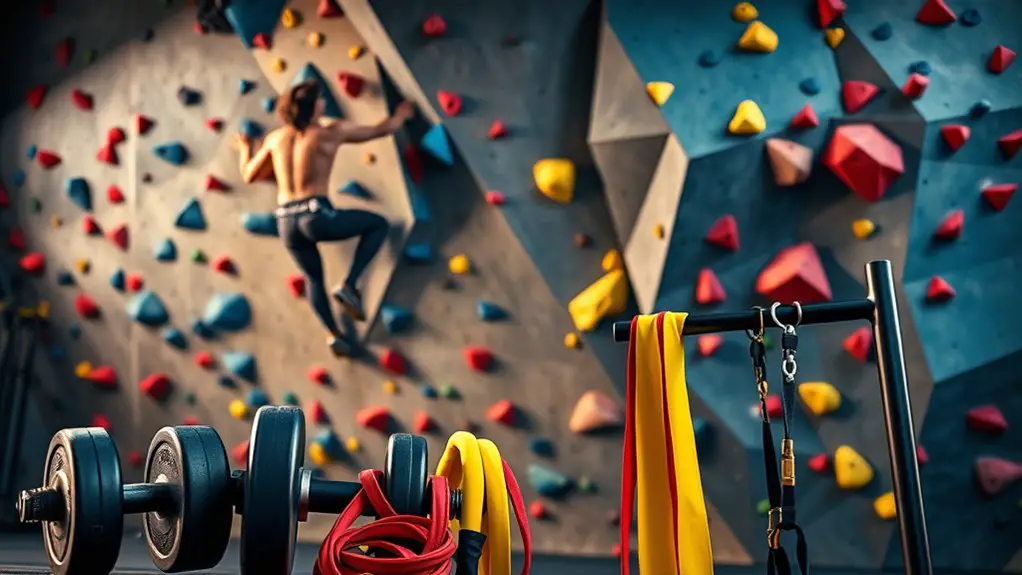
The best gym workouts for rock climbers focus on strength, endurance, and flexibility. You’ll want to target key muscle groups, including your shoulders, core, and legs, with exercises like pull-ups, squats, and lunges. Don’t forget grip strength training to boost your performance on the wall. Incorporating endurance workouts, such as circuit training, helps enhance your stamina. By mixing in climbing-specific equipment, you’ll take your training to the next level. Explore more ways to elevate your climbing game!
Benefits of Strength Training for Climbers

When you commit to strength training, you’re not just building muscle; you’re enhancing your climbing performance considerably. This type of training helps improve your overall stability and endurance, allowing you to tackle more challenging routes with confidence. One of the key benefits is muscle recovery. By strengthening your muscles, you create a more resilient body that can recover quicker after intense climbs, reducing fatigue and soreness.
Additionally, strength training plays an essential role in injury prevention. A well-rounded program strengthens not just your major muscle groups but also the smaller stabilizing muscles and connective tissues that are often overlooked. This balanced approach helps protect you from strains and tears, keeping you safe while climbing. Overall, integrating strength training into your routine fosters a safer, more effective climbing experience, ensuring you can enjoy the sport you love for years to come.
Key Muscle Groups for Climbing
Understanding the key muscle groups for climbing is essential for maximizing your performance on the rock. Strong shoulders and core stability are vital, as they help you maintain control and reduce the risk of injury during challenging climbs. Focus on shoulder stability to enhance your ability to reach and pull efficiently while keeping your joints protected.
Equally important is leg strength. Your legs provide the foundation for upward movement, allowing you to push yourself off footholds effectively. Strong quads, hamstrings, and calves will help you maintain balance and conserve energy as you ascend. Incorporating targeted exercises for these muscle groups into your training routine can greatly improve your climbing performance. Remember, a well-rounded approach to strength training not only boosts your climbing ability but also promotes overall safety, ensuring you can enjoy the sport for years to come. Additionally, exercises like hanging leg raises can effectively target your core and upper body strength, which are crucial for climbing success.
Effective Upper Body Workouts
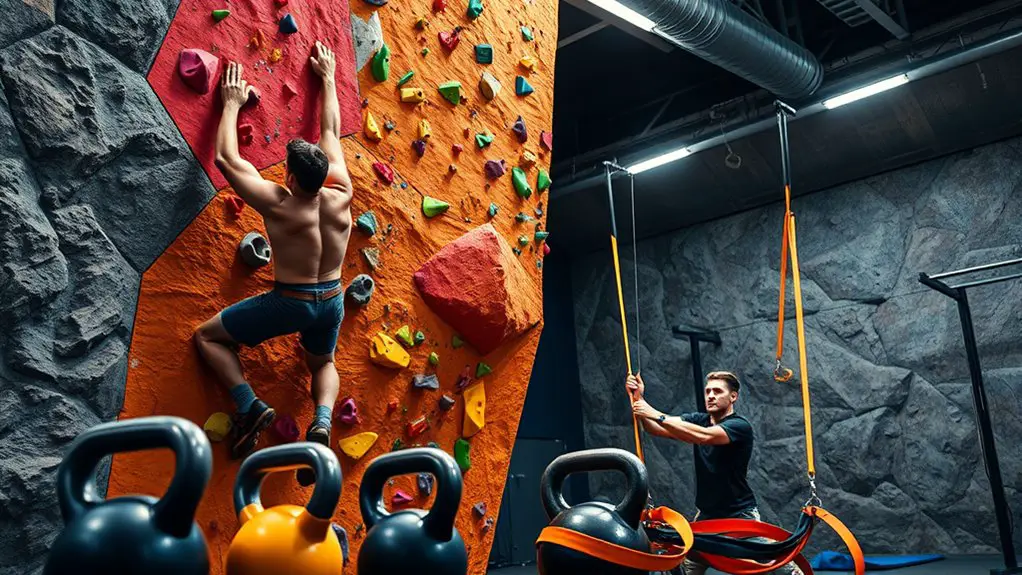
To excel in rock climbing, you can’t underestimate the significance of effective upper body workouts. Focusing on your upper body strength not only enhances your climbing performance but also guarantees your safety while maneuvering challenging routes.
Effective upper body workouts are essential for improving climbing performance and ensuring safety on challenging routes.
Incorporate pull up variations into your routine, like wide-grip or one-arm pull-ups, to target different muscle groups and improve grip strength. Start with assisted pull-ups if needed, gradually progressing to full variations as you build strength.
Push up progressions are equally crucial. Begin with standard push-ups, then advance to decline or archer push-ups to engage your chest, shoulders, and triceps more effectively. Additionally, consider integrating the Half-Kneeling Cable Press into your routine to further engage your core while enhancing upper body strength.
Always listen to your body and prioritize proper form to avoid injuries. Consistently integrating these exercises will strengthen your upper body, making you a more confident and capable climber. Remember, safety first—never push yourself beyond your limits.
Lower Body Exercises for Climbing Power
While many climbers focus on upper body strength, neglecting lower body exercises can limit your climbing power and efficiency. Strong legs are essential for pushing off holds and maintaining balance on the wall. Incorporating squat variations, like front squats or single-leg squats, can enhance your leg strength and stability, which is significant for climbing success.
Additionally, mastering lunge mechanics is important, as lunges help improve your dynamic movement and flexibility when reaching for footholds. Aim for controlled movements to prevent injury and guarantee proper form. You might consider adding resistance bands or weights to your lunges for increased intensity, but always prioritize safety over performance. Furthermore, engaging your core muscles can significantly improve your balance and stabilization during climbs.
Core Strength: The Foundation of Climbing
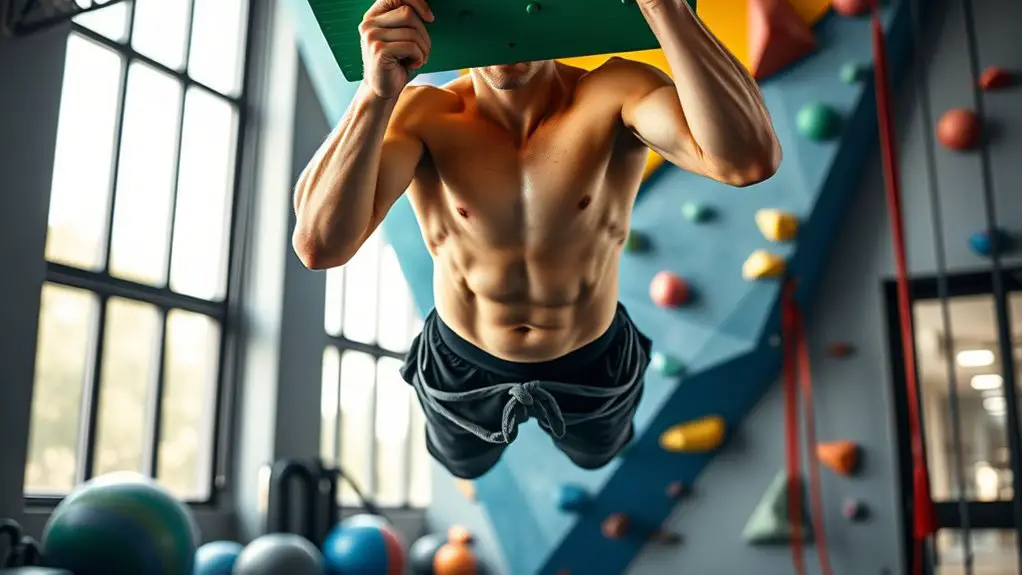
Core strength is crucial for every climber looking to enhance their performance on the wall. A strong core provides the core stability needed to maintain control during challenging ascents. When you engage in dynamic movements, your core acts as a stabilizing anchor, allowing you to shift your weight effectively and execute precise foot placements.
Incorporating exercises like planks, Russian twists, and hanging leg raises into your gym routine can greatly improve your core strength. These workouts not only help develop the muscles around your abdomen and lower back but also enhance your balance and coordination, which are essential for safe climbing.
Grip Strength Training Techniques
When it comes to grip strength, fingerboard training methods are essential for building your finger power. You can also incorporate weighted hang techniques to further challenge and enhance your grip. Let’s explore how these techniques can boost your climbing performance.
Fingerboard Training Methods
To effectively enhance your grip strength for climbing, incorporating fingerboard training into your routine is essential. Start with fingerboard progression techniques that suit your current ability level. Begin with larger holds before gradually moving to smaller ones. This approach minimizes the risk of injury while you build strength.
As you gain confidence, explore advanced grip strategies, like varying your hand positions and using different grip types, such as open-handed or crimp grips. Always listen to your body; if you feel pain, take a step back. Aim for short, focused sessions, allowing ample recovery time to avoid overtraining. With consistent practice, your grip strength will improve, boosting your climbing performance and keeping you safe on the wall.
Weighted Hang Techniques
Weighted hang techniques are a powerful way to boost your grip strength for climbing. By incorporating weighted hangs into your training, you can develop the endurance and strength necessary for those challenging routes. Start with a manageable weight and gradually increase it as you become more comfortable. Verify you use proper form to prevent injuries—focus on keeping your shoulders engaged and your core tight.
For advanced techniques, try varying your grip positions or using different holds, which can further challenge your muscles. Always listen to your body; if you feel pain or discomfort, take a step back. Remember, consistency is key, but safety should always come first. These techniques can greatly enhance your climbing performance when done correctly.
Flexibility and Mobility Workouts
While many climbers focus on strength and endurance, flexibility and mobility are just as essential for enhancing your performance on the wall. Incorporating dynamic stretching and yoga poses into your workouts will help improve your range of motion and reduce the risk of injury.
Here’s a quick guide to some effective exercises:
| Exercise | Benefits | Tips |
|---|---|---|
| Dynamic Lunges | Increases hip and leg flexibility | Keep your core tight |
| Downward Dog | Enhances overall body stretch | Focus on deep breathing |
| Pigeon Pose | Opens hips and improves mobility | Ease into the stretch |
Make sure to warm up properly before starting these movements, and listen to your body. Practicing these flexibility and mobility workouts regularly will not only prepare you for climbing but also contribute to your overall safety and performance.
Endurance Training for Climbers
As you tackle longer and more challenging climbs, building your endurance becomes essential for maintaining performance and preventing fatigue. Focusing on climbing endurance and enhancing your aerobic capacity will help you conquer those tough routes. Here are three effective ways to train:
Building endurance is key to tackling challenging climbs and preventing fatigue while enhancing your aerobic capacity.
- Interval Training: Incorporate high-intensity intervals into your cardio sessions. Alternate between short bursts of effort and recovery periods to boost your stamina.
- Circuit Training: Combine strength exercises with minimal rest. This keeps your heart rate elevated, simulating the demands of climbing and improving your endurance.
- Endurance Climbing: Spend time on the wall, climbing at a lower grade for extended periods. Aim for 20-30 minutes of continuous climbing to build your aerobic capacity safely.
Utilizing Climbing-Specific Equipment
Utilizing climbing-specific equipment can greatly enhance your performance and overall experience on the rock. By incorporating specialized climbing gear into your gym workouts, you’ll not only boost your strength but also improve your technique. Training tools like hangboards and campus boards are essential for building finger strength and explosive power.
Make sure to use these tools safely—always warm up properly to prevent injuries. Also, consider using a crash pad or mat under your training area to cushion any falls.
Incorporating resistance bands can aid in developing stability and strength for your core, which is vital for climbing. Don’t overlook the importance of a good harness and climbing shoes while training. They’ll help you get used to the fit and feel, preparing you for actual climbs. Remember, the right climbing gear and training tools can make a significant difference in your climbing journey. Stay safe and climb smart!
Creating a Balanced Workout Routine
To create a balanced workout routine for rock climbing, it is essential to incorporate a mix of strength training, endurance exercises, and flexibility work. This approach not only enhances your climbing ability but also reduces the risk of injury. Here are three key components to include:
- Strength Training: Focus on core, back, and grip strength to build the muscles necessary for climbing.
- Endurance Exercises: Incorporate activities like running or cycling to improve your stamina, vital for long climbs.
- Flexibility Work: Regular stretching and mobility exercises help prevent injuries and enhance your range of motion.
Additionally, including jump rope in your routine can also engage your core and contribute to overall muscle toning. Consider cross training benefits by mixing these workouts throughout the week. Aim for a workout frequency of 3-5 times a week, allowing your body to recover adequately. This balanced routine will not only prepare you for climbs but also guarantee you stay safe and injury-free on the wall.
Frequently Asked Questions
How Often Should Climbers Train in the Gym Each Week?
When considering how often you should train in the gym each week, it’s essential to balance training frequency with recovery importance. Generally, training three to five times weekly can be effective, but listen to your body. If you’re feeling fatigued or sore, don’t hesitate to take a rest day. Prioritizing recovery guarantees you stay injury-free and enhances your overall performance. Remember, quality training sessions are more beneficial than simply increasing the number of days you train.
What Should I Eat Before a Gym Workout for Climbing?
Before your gym workout, focus on pre workout snacks that provide a mix of carbs and protein. A banana with peanut butter or a granola bar works well. Don’t forget hydration strategies; drink water before and during your session to keep your energy levels up. Staying properly fueled and hydrated helps prevent cramps and fatigue, so listen to your body and adjust your intake as needed for a safe and effective workout.
Can Yoga Help Improve My Climbing Performance?
Can yoga really enhance your climbing performance? Absolutely! While climbing demands strength and power, yoga offers incredible benefits for flexibility and balance, which are vital for reaching those tricky holds. By incorporating yoga into your routine, you’ll not only improve your climbing flexibility but also foster mindfulness and body awareness, helping you stay safe and focused during tough climbs. So, don’t underestimate the power of a good stretch before you hit the wall!
How Do I Prevent Injuries While Training for Climbing?
To prevent injuries while training for climbing, it’s essential to focus on injury prevention strategies. Start with effective warm-up routines that prepare your body for the demands of climbing. Incorporate dynamic stretches and mobility exercises to increase flexibility and range of motion. Additionally, listen to your body—if something feels off, don’t push through the pain. Prioritize recovery, hydration, and proper nutrition to support your training and keep injuries at bay.
Should I Focus on Cardio for Climbing or Strength Training?
When you’re on the climbing wall, it’s like dancing with gravity, and you need both strength and endurance to master the moves. Focusing solely on one can leave you off-balance. Strength training builds the muscles that help you grip and pull, while cardio enhances your endurance for longer climbs. Balancing both is key to optimizing your climbing performance and minimizing injury risks. So, embrace a blend of strength and endurance for your safety and success.

